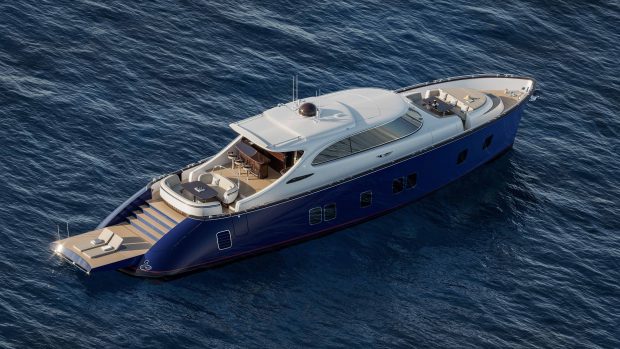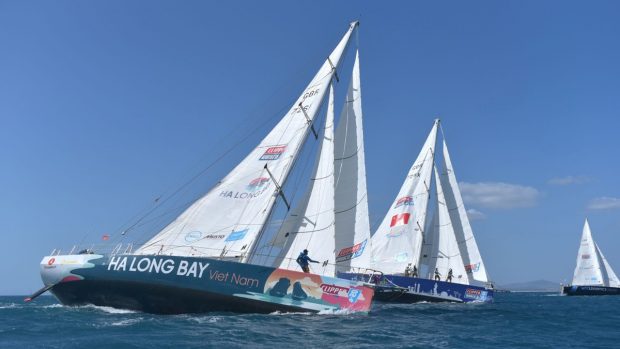RNLI crew awarded medals after rescue in conditions likened to the Roaring Forties
 Motor Boat & Yachting’s December issue reports on the rescue of a yacht by Barra RNLI lifeboat in conditions likened to the Roaring Forties.
Motor Boat & Yachting’s December issue reports on the rescue of a yacht by Barra RNLI lifeboat in conditions likened to the Roaring Forties.
Both boats suffered knock-downs in the huge seas and the lifeboat’s coxswain Donald MacLeod was awarded the charity’s Bronze Medal for his actions.
Here, as promised, is the RNLI’s official dramatic account of the rescue:
The Vijara, a 12m aluminium racing yacht, was participating in the ’round the UK, Ireland and Shetland yacht race’ and was on passage from Castlebay, Barra to Lerwick. After 24 hours at sea in atrocious weather, (described by Pete Goss, as *worse than the Roaring Forties in the Southern Ocean), the two crew were exhausted and had shortened sail prior to both getting a couple of hours sleep. They were woken by being flung around the cabin as the yacht was picked up by a huge breaking wave and went stern over bow and then over 100 degrees onto her starboard side leaving the mast under water.
The keel had shifted to port and damaged the hull. Under the chain plates the hull plates had broken their welds where they were attached to the frames and the mast spreaders had pushed into the mast, slackening the rigging, putting the mast at risk of collapse. The radar scanner had been bent on the top of its mast. The wind instruments and navigation lights on top of the main mast had been washed away, leaving just the VHF aerial and wind vane, neither of which worked correctly. Water had entered the main cabin and all the boats electronic navigation aids had been disabled. The skipper had a badly gashed forehead and the interior of the yacht had sustained significant damage by flying debris. The skipper put out a call for assistance, received by Stornoway Coastguard, and the RNLI Barra lifeboat was requested to launch at 8.37am.
While the RNLI Barra volunteer lifeboat crew were mustering Coxswain Donald MacLeod established the position of the yacht, her condition, the best route to her, and the safest return route. Coxswain MacLeod was concerned that, due to the weather conditions, a passage through the Sound of Barra would be extremely dangerous for the yacht, and was even reluctant to take the lifeboat through. However he thought the yacht skipper, without any local knowledge, might head for the Sound in an attempt to reach safety. To prevent this, Coxswain MacLeod decided to pass through the Sound of Barra to intercept the yacht.
At 8.53am the RNLI severn class lifeboat, Edna Windsor, launched from Castlebay, Barra with five crew on board and Coxswain MacLeod in command.
In the lee of Barra, the wind was blowing from the west force 8 and a two metre swell was running from the same direction. Heavy showers were restricting visibility to less than 1/2 a nautical mile. It was Low water with High Water due at 1544.
As the lifeboat passed up the east side of Barra, losing the shelter of the land, the weather conditions worsened. The wind was exceeding force 9 from the west and Coxswain MacLeod became more concerned as to the conditions in the Sound of Barra. He contacted his father who lives overlooking the Sound of Barra, asking him which of the three known routes through the Sound would be the best option to take. His father replied, ‘it did not matter because the conditions were as bad as they ever get. The 10 – 11 metre Atlantic swell was breaking right through the Sound of Barra for about 2 miles’.
VHF radio contact with the yacht was established as the lifeboat rounded to the north of Fuday. The initial estimated time of arrival (ETA) given to the yacht was revised when the extent to which the weather conditions would slow the lifeboat was fully realised and the yacht’s updated position established. When the revised ETA was passed to the yacht’s skipper he became increasingly concerned with the extent of the damage to his vessel and the length of time before the lifeboat would reach him. Therefore Coxswain MacLeod warned the yacht skipper not to close the Sound of Barra and to keep heading south south east for the southern tip of Barra and the Sound of Sandray.
As the lifeboat entered the shallow waters of the Sound of Barra Coxswain MacLeod was forced to reduced speed to 5 knots. Even though the tide was slack, each 10 – 11 metre wave broke over the lifeboat. Coxswain MacLeod ordered all five crewmembers to strap into their seats, an order he did not rescind until the lifeboat was back in the lee of Barra some three hours later.
Regular communication with the yacht enabled the lifeboat crew to plot electronically an interception course, based on the yacht’s course and speed. At 10.00am the RNLI lifeboat entered deeper water, west of the Sound of Barra. As the swell became slightly more regular and broke less frequently Coxswain MacLeod was able to increase speed to 12 knots.
The lifeboat sighted the yacht at 10.34am. At this time it was established that the electronic chart plotter was malfunctioning. Coxswain MacLeod would have to rely upon his local knowledge because the movement of the lifeboat made the use of a chart impossible and the radar information was scanty and unreliable due to the wave height.
The yacht was making good 6 knots with minimal sail up and the mast and standing rigging seemed to be remaining stable despite the damage. Coxswain MacLeod established the yacht’s skipper would be able to maintain a course that would allow them to reach the Sound of Sandray. The entrance to this sound is very narrow (300m wide) to the unmarked sand bars that extend from both the north and south sides of the sound. Coxswain MacLeod knew that this would be the best route for the yacht to reach calmer waters as the sandbars would protected them from the swell. Additionally the lifeboat would be able to lead the yacht through the sound.
As both vessels approached the entrance to the Sound of Sandray, Coxswain MacLeod used his local knowledge, to position the lifeboat ahead of the yacht to lead the way.
At 11.45am with both engines at idle ahead and the sea on the starboard quarter, the lifeboat was struck by a particularly large cresting wave knocking her onto her port side, and causing her to heel to about 100 degrees. The wave broke right over the lifeboat and the weight of water caused the starboard forward vent casing to be cracked in three places, 1/2 metre of the port toe rail on the forward deck to be lifted, and the starboard A frame ropes to be carried away However, none of the crew were injured due to Coxswain MacLeod’s command that ensured they were strapped in.
Despite being knocked down Coxswain MacLeod maintained the lifeboat’s position and led the yacht into the more sheltered water of the Sound of Sandray and into Castle Bay. A doctor was called to meet the lifeboat and yacht at the lifeboat berth when they arrived at 12.20pm. The yacht was kept alongside the lifeboat until the following morning when the weather had abated and the skipper had recovered sufficiently to survey the extent of the damage and move her to a mooring. The lifeboat was refuelled and ready for service at 1pm.








